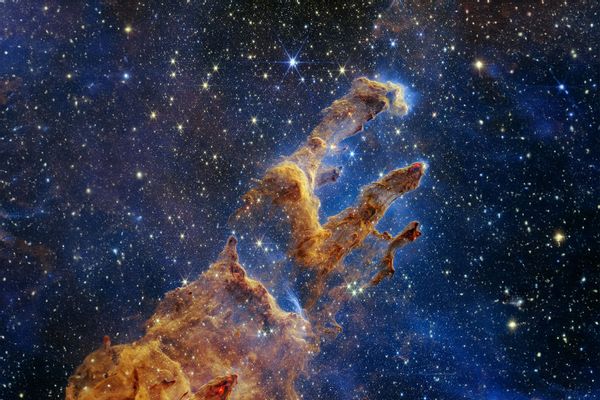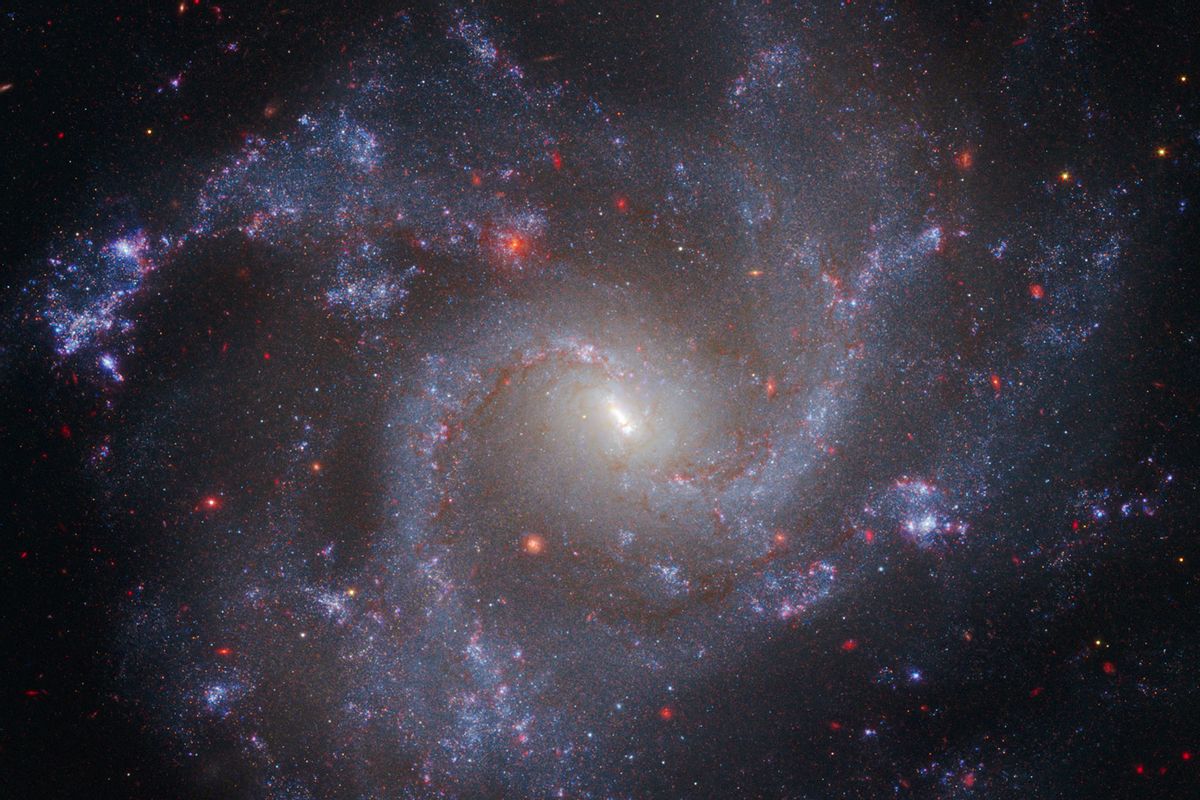This month marks three years since the James Webb Space Telescope was first launched, which still feels something like a miracle given how many years of delays it took to finally get it orbiting our planet. The advanced technology onboard the spacecraft hasn't just sent back some pretty pictures, it's also challenged some of the basic tenets of cosmology, the study of some pretty big questions, including how the universe formed and how we got here.
For decades, the cosmological field was working under the assumption that, after the universe began in a hot dense soup of energy that expanded in the Big Bang, it continued to expand, forming the galaxies and stars that make up the universe. But in recent years, this understanding of how the universe expands has been put into question as two independent measurements to calculate this rate, which is called the Hubble constant, mysteriously diverged. In other words, we're trying to find out the speed limit of the expanding universe, but some measurements have given us different answers.
“The question arose: Is this a real discrepancy?” said Wendy Freedman, the leader of the Chicago Carnegie Hubble Program (CCHP). “Is this indicating new physics and demanding that we change our understanding of what we know as the standard model of cosmology — or were there still systematic uncertainties that made it seem like there was a tension?”
Over the past decade, scientists have been retracing their steps to try and understand whether a mathematical error was behind the conflicting numbers or whether this disparity meant the way cosmologists were imagining the model of the universe was in some way flawed. But time and again when researchers crunch the numbers, the tension persists.
"There is nothing more exciting than not understanding something."
Because the Hubble constant factors into what we know about the age of the universe, its size, and what it's made of, this divergence, known as the “Hubble tension,” has begun to unravel our fundamental and previously held assumptions about reality.
“There is nothing more exciting than having something not work out because it is pointing to the fact that you don’t understand something,” said Adam Frank, an astrophysics professor at the University of Rochester. “There is nothing more exciting than not understanding something.”
In 1929, Edwin Hubble discovered that galaxies in the universe were moving away from us at a rate directly proportional to the distance the galaxy was from Earth. In other words, things further away were moving faster. As a result of this observation, Hubble concluded that the universe must be expanding, and his calculated rate of expansion became known as the Hubble constant.
Want more health and science stories in your inbox? Subscribe to Salon's weekly newsletter Lab Notes.
The Hubble constant can be measured in two ways. The distance ladder method involves measuring objects, like bright stars called Cepheids or stars at the tip of the red giant branch, and comparing them to objects further away to determine the rate of expansion. The second method, called the early relic method, involves measuring the leftover light from the Big Bang in what is called the cosmic microwave background.
In the former method, scientists calculate that the expansion rate of the universe is about 73 km/s/Mpc, and in the latter they calculate that it is about 67 km/s/Mpc. That mpc is what's known as a megaparsec, roughly 3,260,000 light years. Although the difference between 67 and 73 might seem small, it is statistically significant and has persisted throughout more than 10 years of calculations of distances across the universe performed to determine the expansion rate.
 The NIRCam (Near-Infrared Camera) instrument on NASA’s James Webb Space Telescope’s reveals a portion of the Milky Way’s dense core in a new light. An estimated 500,000 stars shine in this image of the Sagittarius C (Sgr C) region, along with some as-yet unidentified features. (NASA, ESA, CSA, STScI, and S. Crowe (University of Virginia))When the James Webb Telescope came online in 2021, it promised to give a clearer picture of the universe that could help cosmologists better measure some of these distances and therefore the expansion rate. But the high-resolution images thus far have confirmed that the tension persists.
The NIRCam (Near-Infrared Camera) instrument on NASA’s James Webb Space Telescope’s reveals a portion of the Milky Way’s dense core in a new light. An estimated 500,000 stars shine in this image of the Sagittarius C (Sgr C) region, along with some as-yet unidentified features. (NASA, ESA, CSA, STScI, and S. Crowe (University of Virginia))When the James Webb Telescope came online in 2021, it promised to give a clearer picture of the universe that could help cosmologists better measure some of these distances and therefore the expansion rate. But the high-resolution images thus far have confirmed that the tension persists.
A study published today in The Astrophysical Journal using images from the JWST confirmed the measurements made by the Hubble telescope, ruling out the possibility that the tension was caused by differences in telescope measurements or some other error in the Hubble telescope. However, the JWST is still relatively young, meaning its dataset is much smaller than Hubble's so far.
With larger and larger sample sizes, the chance that the Hubble constant is caused by a mistake continues to decrease and the chances that the divergence in numbers is being caused by something else we don’t yet understand increases.
“If there was some simple knob that one could turn that would reconcile this, we would happily turn the knob and reconcile it,” said Daniel Eisenstein, the chair of the theoretical cosmology department at Harvard University. “People routinely investigate dozens of other alternatives, and none of those alternatives particularly fix this problem.”
"If there was some simple knob that one could turn that would reconcile this, we would happily turn the knob and reconcile it."
Theorists haven’t been able to come up with a solution to the Hubble tension that could explain the difference yet either, said Saul Perlmutter, a Nobel Prize–winning cosmologist at the University of California, Berkeley. One of the challenges in doing so is that the model does help explain many other elements of the universe with high certainty.
“The Hubble constant is one of the basic constants that you can put into all of these different equations that works so well, so we know we can’t just say 'let’s just start over again,'” Perlmutter told Salon in a phone interview. “We know that there is something right about our picture of cosmology because we are getting so many things well-predicted and understood.”
One possibility is that dark energy, which is thought to comprise roughly 68% of the universe and cause the universe to expand, could be behaving in a way that we don’t understand and that the current cosmological model doesn’t fully explain it. It could also involve the formation of magnetic fields in the early universe or another particle in the universe called the neutrino.
“The obvious places to look for new physics are the places we don’t fully understand, like dark matter and dark energy,” said Dr. Andreea Font, a computational astrophysicist at Liverpool John Moores University in England.
 The Pillars of Creation are set off in a kaleidoscope of color in NASA’s James Webb Space Telescope’s near-infrared-light view. The pillars look like arches and spires rising out of a desert landscape, but are filled with semi-transparent gas and dust, and ever changing. (NASA, ESA, CSA, STScI, Joseph DePasquale, Anton M. Koekemoer, Alyssa Pagan)Historically, “tensions” in cosmology have resulted in major breakthroughs in discovery. At the turn of the 20th century, it was believed that light was propagated through an invisible medium called the luminiferous ether, but scientists could not prove the existence of the ether with data. Then, Albert Einstein solved the tension by coming up with the theory of relativity, which explains how massive objects cause distortions in spacetime.
The Pillars of Creation are set off in a kaleidoscope of color in NASA’s James Webb Space Telescope’s near-infrared-light view. The pillars look like arches and spires rising out of a desert landscape, but are filled with semi-transparent gas and dust, and ever changing. (NASA, ESA, CSA, STScI, Joseph DePasquale, Anton M. Koekemoer, Alyssa Pagan)Historically, “tensions” in cosmology have resulted in major breakthroughs in discovery. At the turn of the 20th century, it was believed that light was propagated through an invisible medium called the luminiferous ether, but scientists could not prove the existence of the ether with data. Then, Albert Einstein solved the tension by coming up with the theory of relativity, which explains how massive objects cause distortions in spacetime.
Other tensions in cosmology co-exist with the Hubble tension today as well. The S8 tension arose when measurements of how clustered galaxies were in the universe diverged, and JWST also illuminated tensions in how massive early galaxies are compared with how massive they were predicted to be under the current model.
Data from the Dark Energy Spectroscopic Instrument (DESI) research group has reported that dark energy might be evolving or thawing in a way that wouldn’t fit with the current cosmological model. This was another “crack” in the current cosmological theory to explain the universe, said Adam Reiss, an astrophysicist at Johns Hopkins University who was a co-winner of the 2011 Nobel Prize in Physics for the discovery of dark energy.
“If this isn’t the right model and someday we have a new understanding, in the best case, all of these cracks may become part of what cements a new model,” Reiss told Salon in a video call. “But we’re not at that stage yet. We are at the finding the cracks stage.”
It could be that a universal solution solves all of these tensions at once and fundamentally changes our understanding of the universe. Or, they might be tackled one by one. However, the field is still in the stage of completely ruling out the possibility that the Hubble tension is in fact being caused by an error or something that was overlooked in the current model.
We need your help to stay independent
“We’ve seen over the last several years what you might call cracks in the model, and the Hubble tension would be the chief crack,” Reiss said. “But there are others as well, and some people have a feeling that we may be on the edge of overthrowing the model with some new understanding. But the challenge is, nobody knows quite what that is.”
With the launch of the JWST, along with other telescopes at the Vera Rubin Observatory, many in the field are hopeful that they might know what is behind the Hubble tension within the next few years, if not sooner.
Although some have referred to the Hubble tension as a “crisis” or a “problem,” many in the field are excited by it, as it opens up the possibility of discovering something entirely new in the universe that helps us better understand it.
“When I look at something and I don’t understand what it is, somebody might say that is a problem” Reiss said. “I would say: That is an opportunity.”
Read more
about space



Shares